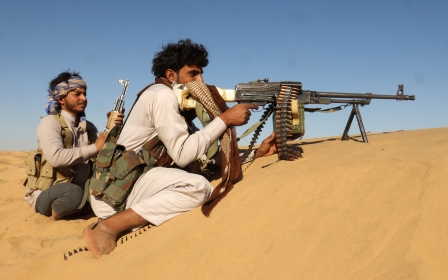Yemen: Who are the UAE-backed Giants Brigades?

It has been one of the most significant pro-Yemeni government forces victories in recent years: over two weeks, the Houthi movement was rolled back from its positions in the oil-rich southeastern province of Shabwah.
One force, in particular, has been credited with this dramatic reversal: the Giants Brigades, crack troops known as al-Amaliqa in Arabic, who are backed by the United Arab Emirates.
"All the districts of the province of Shabwah have been totally liberated," the group said on Monday.
"We thank the heroes of the Giants Brigade... and we thank the Arab coalition led by Saudi Arabia and the support of the United Arab Emirates."
Emirati backing
New MEE newsletter: Jerusalem Dispatch
Sign up to get the latest insights and analysis on Israel-Palestine, alongside Turkey Unpacked and other MEE newsletters
Composed of around 15,000 fighters, the Giants Brigades have been a major opponent of the Houthis during Yemen's seven-year civil war. They are part of the Yemeni National Resistance coalition, an independent force fighting on behalf of the internationally recognised government.
Their founder and leader is Abu Zarah al-Mahrami, who established the group in 2015 with the intention of fighting Houthis in the southern city of Aden.
The Brigades have been receiving training and funding from the UAE since that year at least. The UAE "bears all material and logistical costs" for the Giants Brigades, its website said.
According to the Armed Conflict Location & Event Data project (ACLED), the Giants Brigades are primarily composed of ultra-conservative Salafist tribal fighters, mostly from the south of the country but also reportedly including a number who were expelled from the city of Saada by the Houthis in January 2014.
The Yemeni National Resistance, which is composed of the Giants Brigades, the Guardians of the Republic, and the Tihama Resistance, was at one point led by Tareq Saleh, nephew of Yemen's longtime ruler Ali Abdullah Saleh, the former president who was killed by his erstwhile Houthi allies in 2017.
Despite the fact that most of their fighters hail from the south and receive UAE funding, the Brigades have been keen to deny links with the similarly UAE-backed Southern Transitional Council (STC), repeatedly stressing their loyalty to President Abd Rabbuh Mansour Hadi. The STC controls Aden and its environs, and seeks independence for Yemen's south.
For the vast majority of Yemen's conflict, the Giants Brigades have been active in Yemen's west, fighting in Taiz, Hodeidah and down the western coast. However in December they moved east to Shabwah following the sacking of the province's governor, Mohammed Saleh bin Adyo, who had been critical of the UAE's control of the important Balhaf seaport.
His replacement with pro-UAE governor Awadh al-Awlaki prompted the Giants Brigades to move into the province and establish themselves as the main military power.
The move was viewed as a way of backing Awlaki and ensuring UAE dominance in the province, something the group has denied.
"Our colleagues moved to Shabwah as reinforcements to the forces there to liberate Shabwah from the Houthi militia and not for any other reason," a fighter with the brigade on the western coast told Middle East Eye at the time.
He added that securing the province had become a "priority" as it would allow easier use of the Balhaf seaport, which has been under Emirati control since 2016.
Middle East Eye delivers independent and unrivalled coverage and analysis of the Middle East, North Africa and beyond. To learn more about republishing this content and the associated fees, please fill out this form. More about MEE can be found here.





